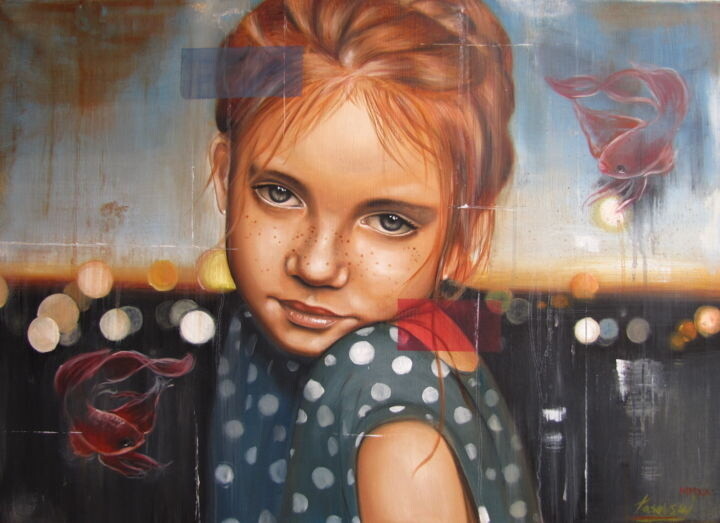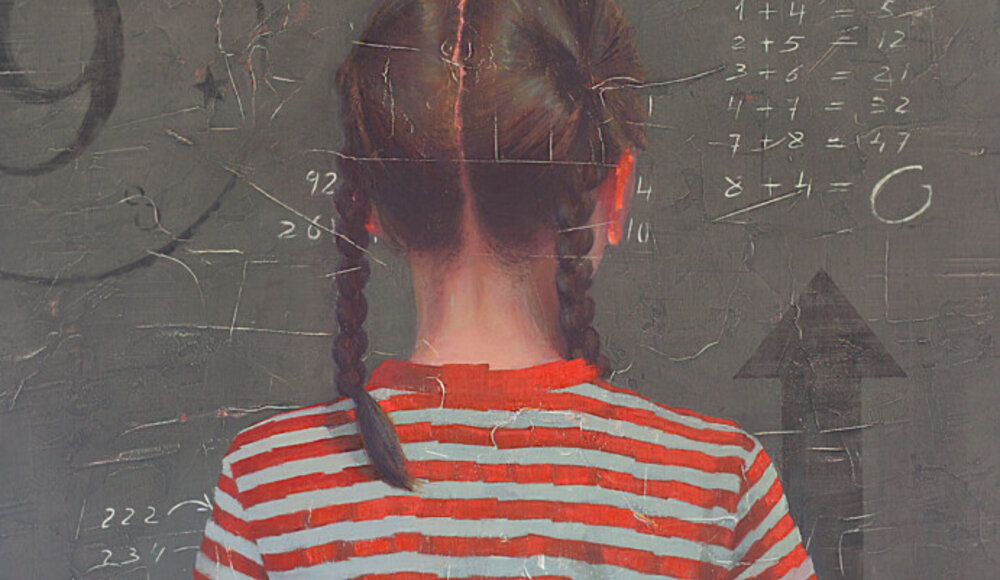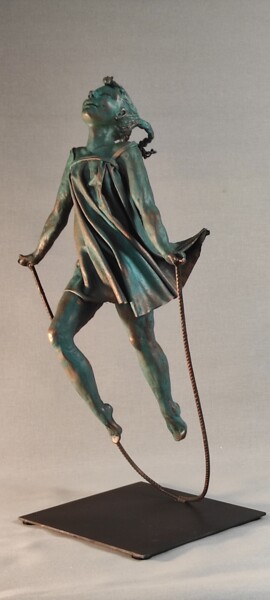 Tomasa Martin, Research II, 2022. Oil / acrylic on wood, 70 x 70 cm.
Tomasa Martin, Research II, 2022. Oil / acrylic on wood, 70 x 70 cm.
 Yuriy Kraft, ***Window III***, 2021. Sculpture, metal / clay on metal, 26 x 20 x 20 cm.
Yuriy Kraft, ***Window III***, 2021. Sculpture, metal / clay on metal, 26 x 20 x 20 cm.
Since the dawn of civilisation, children have represented an extremely popular artistic subject, capable of expressing joy, love and candour, within figurative narratives aimed at illustrating not only the attitudes and psychological characteristics of the little protagonists, but also the customs and habits of their families, as well as the different approaches to the world of childhood, which have characterised the different eras. Among the earliest important examples of the depiction of the aforementioned theme is The Hermes with Dionysus by Parasiteles, a classical Greek sculpture, dating from around 350-330 B.C., which is preserved in the Archaeological Museum of Olympia (Olympia, Greece). This work depicts two humanised deities, namely Hermes naked, upright and leaning against a trunk embellished with drapery, tenderly supporting, on his left forearm, the body of his little brother Dionysus. It is important to emphasise how in the sculpture, a sublime expression of an affectionate, familiar and everyday context, the melancholic gazes of the two protagonists also stand out, capable of revealing both the richness of the human psyche and the intimacy of the fraternal relationship. Early Christian and mediaeval art, on the other hand, largely neglected the depiction of kids, as it focused mainly on the child par excellence, Jesus Christ, often depicted in the company of the Virgin Mary.
 Cimabue, Majesty of the Holy Trinity, c. 1290-1300. Oil on panel, 385 x 223 cm. Florence: Uffizi Gallery.
Cimabue, Majesty of the Holy Trinity, c. 1290-1300. Oil on panel, 385 x 223 cm. Florence: Uffizi Gallery.
An example of this is Cimabue's Majesty of the Holy Trinity, a panel painting from around 1290-1300, preserved in the Uffizi Gallery in Florence. This painting depicts, on a large and articulated ebony throne, the Virgin Mary, who, intent on pointing with her right hand to the Son held in her arms, takes up the attitude of the Byzantine model of the Odigitria, that is, of the Virgin Mary showing Jesus in order to make the way to salvation clear. As for the garments of the protagonists of the work, they are characterised by a precious gilded decoration, called agemina, derived from the Byzantine pictorial tradition, which came back into vogue in medieval Italy. Finally, it is worth highlighting how, around this family scene, there are eight angels delicately supporting the throne, at the base of which we find depictions of some Old Testament prophets. Returning to the story through the centuries, laymen kids reappear in the art world only from the Renaissance period, a period in which we find numerous portraits of children, mostly members of aristocratic or noble families. This trend can be clearly seen in Bronzino's Portrait of Bia de' Medici (1542-45), a work intended to immortalise the natural daughter of Duke Cosimo, born before his marriage in 1539. The young protagonist of the painting, raised together with the sovereign's legitimate descendants, fell suddenly ill at the end of January 1542, dying tragically a few weeks later. The duke, grieving over the event, had a plaster death mask made of her, from which Bronzino most probably created the above-mentioned effigy. The commemorative, but also political propaganda function behind these portraits of the children of aristocratic families was increased during the 17th century, as evidenced by Velazquez's iconic painting Las Meninas, which captures the Spanish royal family by emphasizing the figure of the Infanta Margarita.
 Marie Cassàt, Little girl in a blue armchair, 1878. Oil on canvas, 89.5 × 130 cm. Washington: National Gallery.
Marie Cassàt, Little girl in a blue armchair, 1878. Oil on canvas, 89.5 × 130 cm. Washington: National Gallery.
Turning to the nineteenth century, on the other hand, this was a time of great change; in fact, children were portrayed in a decidedly freer and more spontaneous manner, just as demonstrated by Marie Cassàt's Little girl in a blue armchair (1878), an Impressionist painting aimed at immortalizing a child, who, in symbiosis with her dog, appears comfortably reclining on a small armchair the color of the sea. Finally, as for the twentieth century, this century saw kids as the protagonists of highly experimental works, among which Giacomo Balla's Girl running on the balcony (1912) is noteworthy. In fact, in this very futurist painting, one can identify, albeit with some difficulty, the figure of a child who multiplies herself by arranging herself all over the support. On the other hand, about the orthogonal grid that can be perceived superimposed on the images of the little girl, it represents the grating of the balcony of Balla's Roman house; in fact, the protagonist of the work is precisely the great master's daughter, little Luce. Finally, another extremely innovative twentieth-century masterpiece, having as its subject a child, is Little girl in blue, a 1918 painting by Amedeo Modigliani, which immortalizes a kid with a composed pose and a refined face, totally immersed in an intimate and suspended atmosphere.
 Vlatko Tasevski, Cycle of life, 2020. Oil on canvas, 50 x 70 cm.
Vlatko Tasevski, Cycle of life, 2020. Oil on canvas, 50 x 70 cm.
 Denise Souza Finney, Educated hoops playground lessons, 2021. Acrylic on wood, 61 x 61 cm.
Denise Souza Finney, Educated hoops playground lessons, 2021. Acrylic on wood, 61 x 61 cm.
 Sophie Barut, Hope, 2022. Sculpture, bronze on metal, 16 x 7 x 7 cm / 3.00 kg.
Sophie Barut, Hope, 2022. Sculpture, bronze on metal, 16 x 7 x 7 cm / 3.00 kg.
Children in contemporary art
The love of children continues in contemporary art, just as can be seen in the works of some popular artists, such as Ron Mueck, Steve McCurry, Sally Mann and Aleksandr Milov, who are able to capture the essence of childhood within the contradictory world in which we live. That narrative can be considerably enriched by the work of the artists of Artmajeur, who, through different styles, techniques and points of view, but always in touch with the highest figurative tradition, have largely been able to explain to us what it means to be a child today. It is precisely this latter intent that is extremely noticeable within the paintings of Peter Oke, Sufyr, and Christophe Stephan Durand.
 Peter Oke, Symbi’s absence, 2022. Acrylic / airbrush / ballpoint pen / enamel / oil / pastel / pigments / spray on canvas, 122 x 89 cm.
Peter Oke, Symbi’s absence, 2022. Acrylic / airbrush / ballpoint pen / enamel / oil / pastel / pigments / spray on canvas, 122 x 89 cm.
Peter Oke: Symbi’s absence
Peter Oke's painting depicts the intense and melancholy close-up of a little girl, who, silhouetted against a sky-blue background to match her blue dress, is realized, in her face and hair, through a perfect interlocking of wide, narrow circular lines, often capable of revealing to us the underlying color scheme as well. This personal realist technique pursues the intent of conveying an important message about modern childhood, making explicit reference to the daily struggle, and abuse, experienced by an African girl whose parents, who were unable to provide her with an education, took her to sell fish on the streets. When it comes to art history, on the other hand, an important work that pursued the same intentions of child social denunciation, while focusing more on issues related to racism, was Norman Rockwell's The Problem We All Live With (1964), in which the drama of a six-year-old African-American girl, who, for security reasons, had to be escorted inside a white public school, was highlighted.
 Sufyr, Je t'aime, 2020. Acrylic on cardboard, 70 x 50 cm.
Sufyr, Je t'aime, 2020. Acrylic on cardboard, 70 x 50 cm.
Sufyr: Je t’aime
Je t'aime is an acrylic painting on cardboard that, through the stylistic devices and techniques of street art, such as graffiti and tags, immortalized the sweet portrait of a little girl intent on drawing. The love for children, or for the protagonist of the work in particular, sweetly "invades" the entire painting, in which the romantic title of the work is repeated twice, which, accompanied by drawings of hearts, appears as a real sort of celebration of the world of little ones and, in particular, of their ability to love and be loved. On the other hand, speaking of a very popular writer, Bansky, who has often demonstrated his love for children, created, in 2002, the iconic stencil Girl With Balloon, a work marked by a delicate poetics, aimed at alluding to an existential situation of extreme loneliness, narrated by a very sweet girl who lets her balloon fly away.
 Christophe Stephan Durand, Unconditional love, 2020. Oil on canvas, 46 x 37 cm.
Christophe Stephan Durand, Unconditional love, 2020. Oil on canvas, 46 x 37 cm.
Christophe Stephan Durand: Unconditional love
Christophe Stephan Durand's painting, created in an indefinite context in which animal figures stand out suspended in the air, celebrates, in a sort of eternal and timeless dimension, the great love nurtured by a young boy for his beloved feline. In fact, the work lends itself well to summarize that special relationship of affection, friendship and complicity that can be established between children and animals, aimed at becoming concrete within a particular reality made of play, cuddling and fantasy, all too often capable of humanizing our furry friends, transforming them into talking characters, protagonists of fantastic adventures. The love between kids and four-legged friends is a recurring topical theme even within the highest art-historical tradition, found in masterpieces of the caliber of: the Portrait of Giovanni de' Medici as a Child by Agnolo Bronzino, Julie Manet by Pierre-Auguste Renoir, Portrait of a Little Boy with Dog by Domenico Fiasella and Child Playing with Two English Setters by Niccolò Cassana.


 Olimpia Gaia Martinelli
Olimpia Gaia Martinelli























